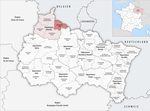Sedan, Ardennes

Sedan (French pronunciation: [sədɑ̃] ) is a commune in the Ardennes department and Grand Est region of north-eastern France. It is also the chef-lieu (administrative centre) of the arrondissement of the same name. Sedan is notable as the site of two major battles between the armed forces of France and Germany, both of which were won by Germany. The First Battle of Sedan in 1870 sealed the fate of the Second French Empire and paved the way to the foundation of the German Empire, leading to the subsequent annual celebration of "Sedan Day" in Germany. The Second Battle of Sedan in 1940 achieved a decisive breakthrough by Wehrmacht forces in the Battle of France and ultimately led to the collapse of the French Third Republic.
Excerpt from the Wikipedia article Sedan, Ardennes (License: CC BY-SA 3.0, Authors, Images).Sedan, Ardennes
Rue Macdonald, Sedan
Geographical coordinates (GPS) Address Nearby Places Show on map
Geographical coordinates (GPS)
| Latitude | Longitude |
|---|---|
| N 49.7034 ° | E 4.9388 ° |
Address
Rue Macdonald
Rue Macdonald
08200 Sedan
Grand Est, France
Open on Google Maps








